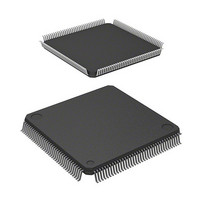R5F61665N50FPV Renesas Electronics America, R5F61665N50FPV Datasheet - Page 522

R5F61665N50FPV
Manufacturer Part Number
R5F61665N50FPV
Description
MCU FLASH 512K ROM 144-LQFP
Manufacturer
Renesas Electronics America
Series
H8® H8SX/1600r
Datasheet
1.R5F61665N50FPV.pdf
(1492 pages)
Specifications of R5F61665N50FPV
Core Processor
H8SX
Core Size
16/32-Bit
Speed
50MHz
Connectivity
EBI/EMI, I²C, IrDA, SCI, SmartCard, USB
Peripherals
DMA, LVD, POR, PWM, WDT
Number Of I /o
92
Program Memory Size
512KB (512K x 8)
Program Memory Type
FLASH
Ram Size
40K x 8
Voltage - Supply (vcc/vdd)
3 V ~ 3.6 V
Data Converters
A/D 8x10b; D/A 2x8b
Oscillator Type
External
Operating Temperature
-20°C ~ 75°C
Package / Case
144-LQFP
Lead Free Status / RoHS Status
Lead free / RoHS Compliant
Eeprom Size
-
Available stocks
Company
Part Number
Manufacturer
Quantity
Price
Company:
Part Number:
R5F61665N50FPV
Manufacturer:
Renesas Electronics America
Quantity:
10 000
- Current page: 522 of 1492
- Download datasheet (8Mb)
Section 11 EXDMA Controller (EXDMAC)
(2)
Burst Mode
In burst mode, once the EXDMAC acquires the bus mastership, it continues transferring data,
without releasing the bus mastership, until the transfer end condition is satisfied. In burst mode,
once transfer is started it is not interrupted even if there is a transfer request for another channel
with higher priority. When the burst mode channel finishes its transfer, it releases the bus
mastership in the next cycle in the same way as in cycle steal mode. However, when the EBCCS
bit in BCR2 of the bus controller is set to 1, the EXDMAC can temporarily release the bus
mastership for another bus master when an external access request is generated from another bus
master.
In block transfer mode and cluster transfer mode, the setting of burst mode is invalid (one-block or
one-cluster transfer is processed in the same way as in burst mode). The EXDMAC always
operates in cycle steal mode.
When the DTE bit is cleared to 0 in EDMDR, EXDMA transfer is halted. However, EXDMA
transfer is executed for all transfer requests generated within the EXDMAC until the DTE bit is
cleared to 0. If a transfer size error interrupt, a repeat size end interrupt, or extended repeat area
overflow interrupt is generated, the DTE bit is cleared to 0 and transfer is terminated.
Figure 11.14 shows an example of the timing in burst mode.
Bus cycle
CPU
CPU
EXDMAC
EXDMAC
EXDMAC
CPU
CPU
CPU cycle not generated
Figure 11.14 Example of Timing in Burst Mode
11.5.5
Extended Repeat Area Function
The EXDMAC has a function for designating an extended repeat area for source addresses and/or
destination addresses. When an extended repeat area is designated, the address register values
repeat within the range specified as the extended repeat area. Normally, when a ring buffer is
involved in a transfer, an operation is required to restore the address register value to the buffer
start address each time the address register value becomes the last address in the buffer (i.e. when
ring buffer address overflow occurs). However, if the extended repeat area function is used, the
operation that restores the address register value to the buffer start address is processed
automatically within the EXDMAC.
The extended repeat area function can be set independently for the source address register
(EDSAR) and the destination address register (EDDAR).
Rev. 2.00 Oct. 21, 2009 Page 488 of 1454
REJ09B0498-0200
Related parts for R5F61665N50FPV
Image
Part Number
Description
Manufacturer
Datasheet
Request
R

Part Number:
Description:
KIT STARTER FOR M16C/29
Manufacturer:
Renesas Electronics America
Datasheet:

Part Number:
Description:
KIT STARTER FOR R8C/2D
Manufacturer:
Renesas Electronics America
Datasheet:

Part Number:
Description:
R0K33062P STARTER KIT
Manufacturer:
Renesas Electronics America
Datasheet:

Part Number:
Description:
KIT STARTER FOR R8C/23 E8A
Manufacturer:
Renesas Electronics America
Datasheet:

Part Number:
Description:
KIT STARTER FOR R8C/25
Manufacturer:
Renesas Electronics America
Datasheet:

Part Number:
Description:
KIT STARTER H8S2456 SHARPE DSPLY
Manufacturer:
Renesas Electronics America
Datasheet:

Part Number:
Description:
KIT STARTER FOR R8C38C
Manufacturer:
Renesas Electronics America
Datasheet:

Part Number:
Description:
KIT STARTER FOR R8C35C
Manufacturer:
Renesas Electronics America
Datasheet:

Part Number:
Description:
KIT STARTER FOR R8CL3AC+LCD APPS
Manufacturer:
Renesas Electronics America
Datasheet:

Part Number:
Description:
KIT STARTER FOR RX610
Manufacturer:
Renesas Electronics America
Datasheet:

Part Number:
Description:
KIT STARTER FOR R32C/118
Manufacturer:
Renesas Electronics America
Datasheet:

Part Number:
Description:
KIT DEV RSK-R8C/26-29
Manufacturer:
Renesas Electronics America
Datasheet:

Part Number:
Description:
KIT STARTER FOR SH7124
Manufacturer:
Renesas Electronics America
Datasheet:

Part Number:
Description:
KIT STARTER FOR H8SX/1622
Manufacturer:
Renesas Electronics America
Datasheet:

Part Number:
Description:
KIT DEV FOR SH7203
Manufacturer:
Renesas Electronics America
Datasheet:











